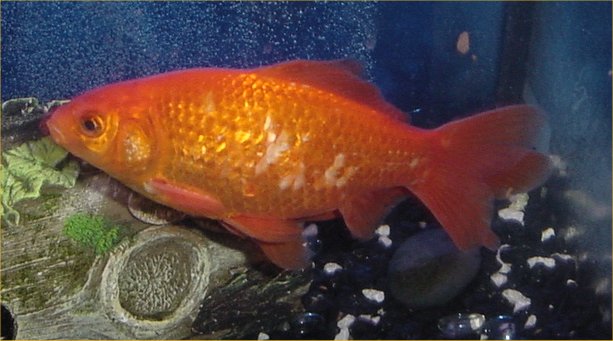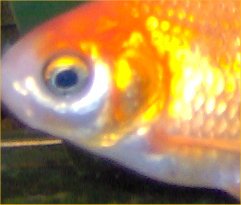 |
 |
|
|
Last Updated: 1/27/09
Sexing
Summary of Sexual Differences
Sexing Links



Sexual maturity in goldfish depends on size, age, sex, and the health of the fish. Male single- tailed goldfish may become mature at only a few inches long while females are normally 3 to 5 inches long before they produce eggs. Fancy goldfish, since they grow smaller, may mature at smaller sizes, certainly by 3 inches in body length even for females.
In a pond setting, sexual maturity usually occurs after about a year. Maturity generally takes longer in an aquarium due to slower growth rates. The exact age of maturity varies with the variety of goldfish and its living situation and can occur anywhere from 9 months to 2 years after hatching.
I was surprised to see tubercles on two of my small fantails when I moved them from my basement pond to my 40 gallon tank. They were under 3" long but got them anyway. The increase in temperature probably put them "in the mood."
Some people will say that sexing goldfish is only possible during breeding. During this time, males chase females who lay eggs. Also, males develop white spots or pimples on their gill covers called breeding tubercles (I have also seen them called "breeding stars" on-line). Often, people mistakenly believe these white spots to be the parasite white spot or ick and treat the healthy fish. Females may develop a tubercle or two but not nearly as many as a mature male. Even during non-breeding times, an experienced person can sex adult goldfish. Koi can be sexed similarly to goldfish but not as readily.
Here is a photo of a dead, 9", red and white, mature female comet full of roe or eggs. I found this goldfish in my 1800 gallon pond on 7/5/02. There were no signs of injury, predation, parasites, infections, funguses, viruses, or little green space men. She was perfectly healthy except her mouth was agape, and she was dead. She was most likely spawning in the shallows on this 95 degree F day and got stuck out of water where she suffocated. The other fish were all fine. Now if I can only get a good photo of a mature male with tubercles! Of course, I do not want any more fish to die!
Proven sexing methods:
Mature female goldfish are usually (but not always) larger, fuller, and have a convex (sticks out) anal opening (vent). They often have a thicker leading ray of the anal fin. Mature males are usually (but not always) thinner, longer, and have a concave anal opening. Excited males may retain breeding tubercles year-round on their gills and the leading ray of their pectoral fins. The leading rays of the seasoned mature males' pectoral fins are often much thicker than females' fins and covered with tubercles. The mature males' pectoral fins may also be longer and more pointed than females' pectorals. The breeding tubercles on the gill plates and pectoral fins are especially obvious on a Black Moor since the spots are white on black.
Sexing methods that may or may not work:
Another method that often works (year round in mature fish) is that females' sides appear asymmetrical (her side sticks out further on one side, uneven sides) when viewed from above whereas males' sides are symmetrical. Yet another option is to put a known female into the tank or pond. Mature males should start chasing and touching her immediately whereas females usually (but not always) are not interested. A few aquarists/ponders have reported that males develop a ridge on their abdomens and females do not. Males may have a more firm abdomen than females (may be due to eggs). Overall fin length is not a good judge of sex. While some people say common (short finned) males have longer fins than common females, my common females seemed to be longer-finned than my males. With fancy-finned goldfish, comparisons of fin length do not work. Males may sometimes be more colorful (bright) than females.

| Body Location | Mature Male | Mature Female |
| Gill plates | White bumps called tubercles present | Few or no tubercles |
| Leading ray of pectoral fins (paired front swimming fins behind gills) | White bumps called tubercles present; thicker edge; more pointed fin | Few or no tubercles; thinner edge; more rounded fin |
| Leading ray of anal fins (small fins near vent) | Thinner | Thicker |
| Vent (where wastes and eggs or sperm exit the fish) | Concave (goes in); smaller opening | Convex (sticks out); larger opening |
| Behavior | Chaser | Chased and harassed |
| Abdomen | Smaller; may have a ridge; more firm abdomen | Larger, fat; no abdomen ridge; more pliable abdomen (if full of eggs) |
| General body shape | Thinner; longer; symmetrical from above | Fatter; shorter; asymmetrical from above (if full of eggs) |

Goldfish sexing site - drawings of the differences between male and female anal regions and information on sexing goldfish; this is an archived version of the now defunct site
Sexing Goldfish - includes drawings of sexual differences.
Goldfish anatomy drawing - identifies the parts of a goldfish
Goldfish Photos - one person took photos of a dead male and female in breeding condition to show sexual differences.

Return to the Main Goldfish Page.
|
|
|

|
|
|
Return to the main fish page.
See the master index for the fish pages.

|

|
E-mail RobynCopyright © 1997-2025 Robyn Rhudy |

|
 |